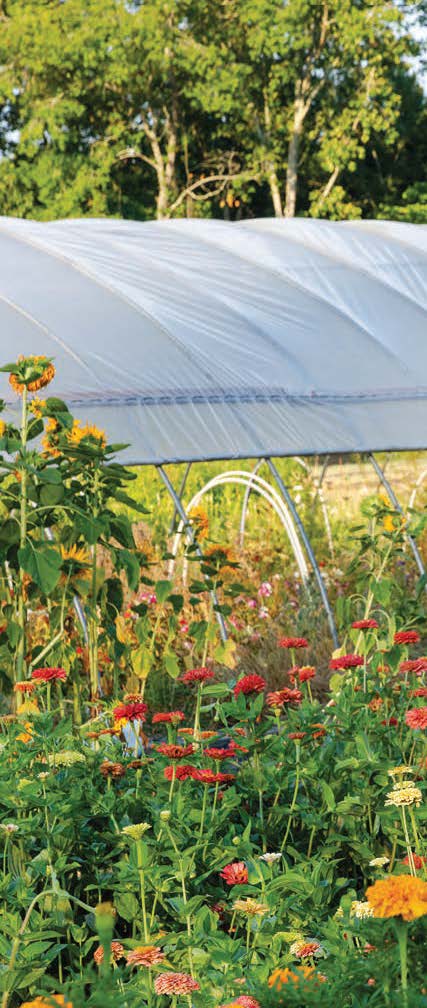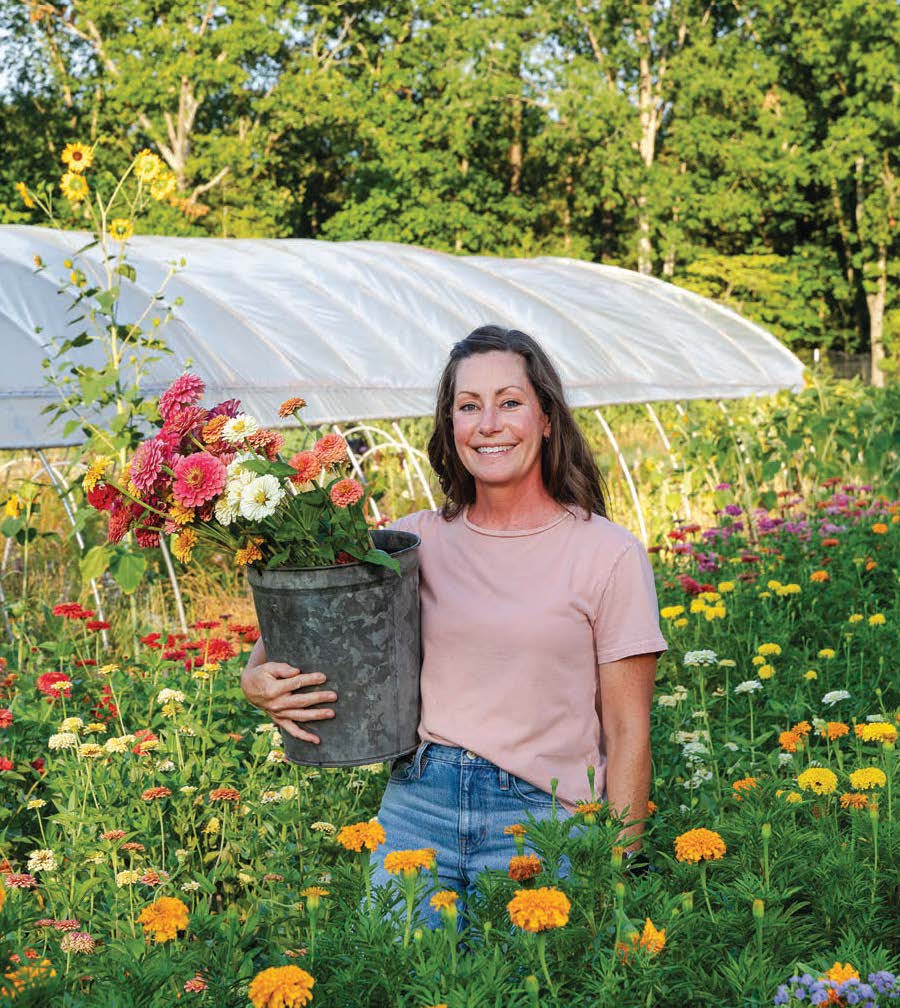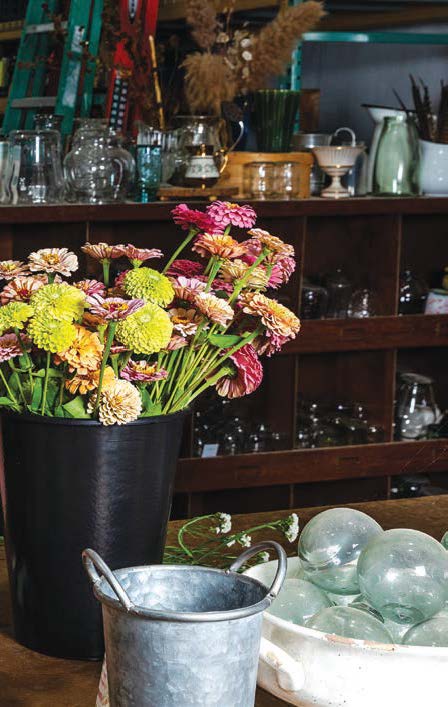ALL IN A DAY'S WORK

All in a Day's Work
Shady Maple Farm glows with color
By Claudia Watson
Photographs by John Gessner
On the outskirts of Carthage, a nondescript dirt road leads to a hidden gem. Surrounded by a tapestry of pines, native oaks, vibrant sassafras and fruit-laden persimmons, the landscape is a remarkable sight in late summer. A weathered sign bearing the word “Flowers” hints at the destination: Shady Maple Farm.
Farther down the long road, you get a glimpse of what is ahead — a breathtaking wildflowers-filled space. And in the heart of it all, a woman in a big straw hat tends her flowers. When Jennifer Donovan and her husband, Aloysius, moved to this parcel of land in 2021, it was a blank canvas. The 67-acre farm inspired them to follow their love for the outdoors and simpler times.
Decades ago, the 80-year-old homestead was timbered. Still, it held great promise with two natural ponds and nearby wetlands that drain into Dunham’s Creek. “I didn’t have a grand plan, and so it evolved,” Donovan says. “It started with a small plot that I planted and filled with summer annuals just so I could learn.”
Weeks later, while driving through the country, the couple spied three, “unused,” envy-inducing hoop houses in a distant field. They finally mustered the courage to ask the owner if they could buy them.
“He agreed, but on one condition: We had to dismantle and transport them ourselves. They were a fraction of the original cost and certainly worth it,” says Donovan, recalling the first hurdle in their journey to expand the farm.
It took some effort, but they assembled the largest of the three hoop houses, providing 2,000 square feet of protected growing space for her spring crop for the past three years. “It’s a joy to work there in the winter. It’s warm and full of sunlight, and I can roll the sides down if it gets too cold and still get work done,” she says as she nips a flower stem.
Working in the dirt has always been part of Donovan’s life. A native of Carthage, she graduated from Union Pines High School before attending East Carolina University. During the summers, she’d mow greens and fairways on local golf courses, a job she enjoyed, leading her to transfer to N.C. State University, where she obtained a degree in agronomy.
“I wanted to understand the soil and how it needed to be healthy, so I focused on environmental stewardship classes. That education, and later, earning my N.C. Cooperative Extension Master Gardener certification, gave me a sincere appreciation for our living soil,” she says. “Putting down roots here led to my flower farm dream. I knew when we bought the land that I’d grow something, but I didn’t know what until I saw information online about cut flower production. I love flowers, and they are a product that’s needed year-round.”
So she signed up for an online course in fresh flower production. “I was hooked, obsessed, consumed,” she says. “I couldn’t wait to get started. As soon as I could break ground, I planted that small plot of flowers.”
Donovan never looked back. She started seeds in late fall of 2020 and began selling flowers in the spring of 2021. Despite COVID, she forged ahead, setting up her floriculture business plan and website, and finding novel ways to sell her flowers in a market segment that will generate $52 billion in sales in 2024.
Driven by people’s increased use of flowers and beautiful plants to liven up their homes and businesses, cut flowers dominate the floriculture market. North Carolina is one of the top 10 states in the U.S. in their production, indicating the enduring appeal and demand for floral beauty.

“Flower farming takes a lot of planning and physical work to succeed,” Donovan says. “I reach my market in a variety of ways, including offering flower subscriptions and joining the local farmers markets. During COVID, when there weren’t many farmers markets, we salvaged what we could from the remnants of the old farmhouse and repurposed them to make a self-serve honor system flower stand.” Donovan points to the stand next to the wildflower garden and their home. “People were very happy to come here to buy flowers to brighten their days.”
Surprisingly, she had not grown anything from seed until they moved to the farm. Donovan laughs at it, too. “I never thought I’d be a flower farmer, but it makes sense with my love of the outdoors and my interest in caring for the environment. For me, it is a perfect match,” she says.

The small-scale family flower farm is no-spray, no-till, and focused on organic growing practices. “December and January are my two months to try and get the farm straightened out,” she says, anticipating the work ahead. After a harvest and before transplanting or seeding another crop, she cuts back or mows down the stems of the season’s plant material and covers them with silage tarps for two to three weeks. She removes the tarps and adds a layer of heavy compost on top.
Another part of the process is determining the number of flowers needed for each season. Donovan uses succession planting to ensure she grows a specific number of stems to fulfill her subscriptions and customers at the farmers market.
“As a one-woman show, efficiency is key,” she says. “Once the season begins it’s like being a hamster on a wheel.”
Flower farming is a time-sensitive operation, and if planned and executed correctly, all those long days in the dirt bring a steady stream of thousands of fresh flowers for her customers. Spring brings the first flush of colors: David Austin roses and the overwintering veronica, salvia, sedum, yarrow, sweet peas and mountain mint — which gets its own box to keep it manageable.
Her 2 acres of flower fields are a veritable candy shop of colorful choices. Versatile plants, including biennial Canterbury Bells (Campanulas) and snapdragons, provide an informal cottage look when intermixed with other plants.
Elegant Bupleurum ‘Griffithi’ with its bright chartreuse blooms combines well with jewel tones, the simple, clean white, of False Queen Anne’s Lace (Ammi majus), and Bells of Ireland. Highly fragrant stock (Matthiola incana), forget-me-nots, poppies and spiky delphiniums are prized plants that thrive in cooler weather. And magical ranunculus, born from small octopusshaped corms that continue to generate stems after being cut, are among her spring favorites.
Donovan loves tulips, but not standard tulips. “I’m drawn to the unusual types that are showy and make a bouquet stand out, with fringed or pointed petals, and the double-flowered,” she says. “Some are so ruffled and full they’re mistaken for peonies.”
Donovan points to a recently weeded row marked with pink flags in the middle of the flower rows. “I’m cultivating 10 to 12 varieties of herbaceous perennial peonies that are suitable to our climate. There are 100 in that row and 1,000 in the ground. I flag them, so I don’t need to find them each time I use my stirrup hoe to weed. I don’t want to cut off the little eyes on the crowns,” she says, noting those eyes generate a mass of new upright shoots.
For the past two years, she has disbudded the peonies to allow a young plant (aged 1-3 years) to strengthen. The most important part of the disbudding ritual is timing. “As soon as I see a bud, I cut it off,” she says. “It’s a sacrifice, but what’s needed to get those deep tuberous roots to focus on storing moisture and food. That growth will chug out the thick foliage and the large bountiful blooms I’ll have in another year or so.”
Early summer brings the dramatic globes of allium, perennial phlox (Phlox paniculata) and black-eyed Susans (Rudbeckia). Once the ground is warm, she plants 600 sunflower seeds every Monday. “Who doesn’t love a sunflower?” she says, spying ladybugs and hovering dragonflies on her healthy crop.
Late summer is usually when a garden runs out of steam. But that’s when the flower harvest at Shady Maple Farm hits its crescendo. It is a breathtaking display of color and abundance, a true testament to the farm’s thriving nature. Zinnias, celosia, amaranth, marigolds, summer snapdragons, heirloom mums and another succession of sunflowers brighten the landscape. But it is the dahlias that elicit a strong emotional response from many.
“Dahlias are so unique, with all shapes, sizes and colors imaginable,” Donovan says. “Plus, one dahlia tuber makes many more tubers in the first season. They never disappoint and are the workhorses.”
Her favorite dahlias include ‘Cafe au Lait’ and ‘Break Out,’ renowned for their creamy blooms in soft pink, beige and peach that make romantic summer bouquets. ‘Lavender Perfection’ is a fully double flower with huge lavender-pink blossoms that can grow 40 inches tall. Dahlia ‘Platinum Blonde’ resembles doubleflowered echinacea with fuzzy buttercream centers surrounded by bright white petals. Pollinators like bees, butterflies and hoverflies are drawn to dahlias’ vibrant colors and diverse forms, finding sustenance from mid-summer to frost.
In May she plants a mass of dahlias to take her through the fall farmers markets, where she sells flowers from her vintage-style bus that she’s named Bloom. “I love this bus,” Donovan shouts while unloading buckets of freshly cut flower stems and wrapped bouquets. “It keeps me efficient. Farming is figuring out how to make it work, understanding where to put the cover crop and get the succession right for smooth transitions.” It requires tough decisions, she notes, adding that the farm’s outdoor capacity has by no means reached its limits. Next year, she will add more rows and 3,900 more plants.

“This farm makes me appreciate the wisdom of farmers who’ve been doing this for a long time. For me, to finally get a system in place feels good,” she says as the sun begins its descent and the flower fields take on a golden glow.
After a long silence, she smiles, grateful for the day. It takes energy, determination and sensitivity to nature’s flora and fauna. Still, for Donovan, it is all in a day’s work — a day that makes her proud.
